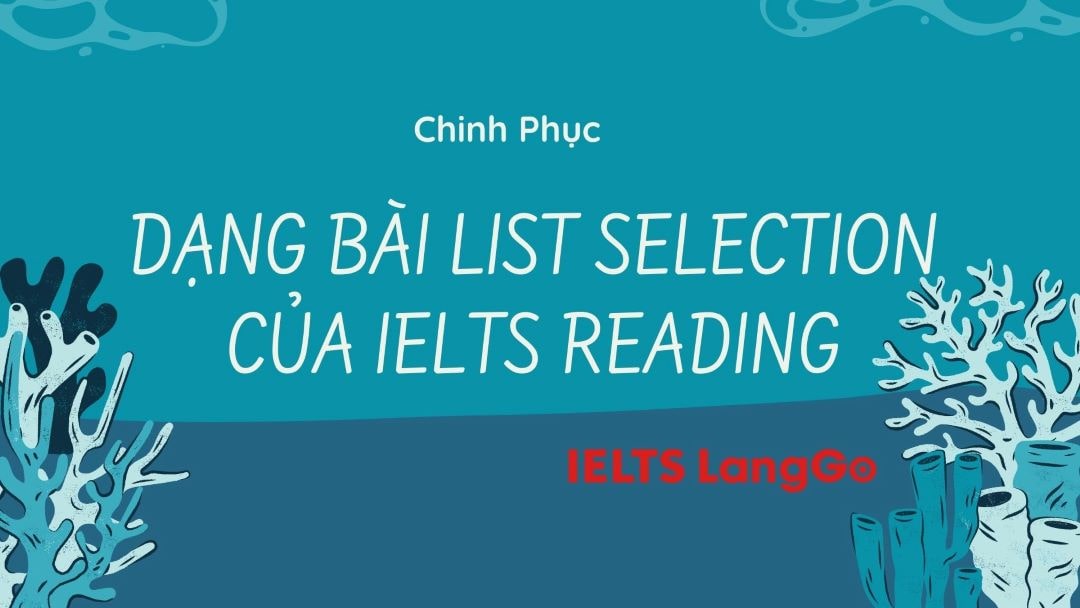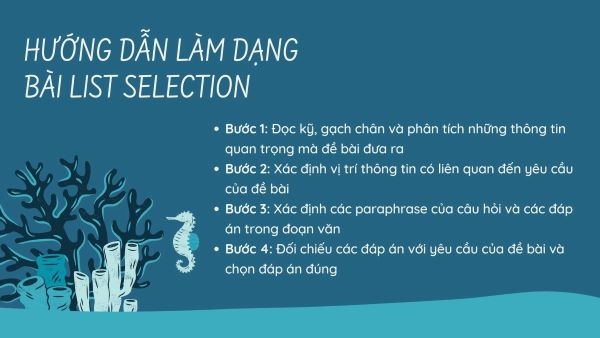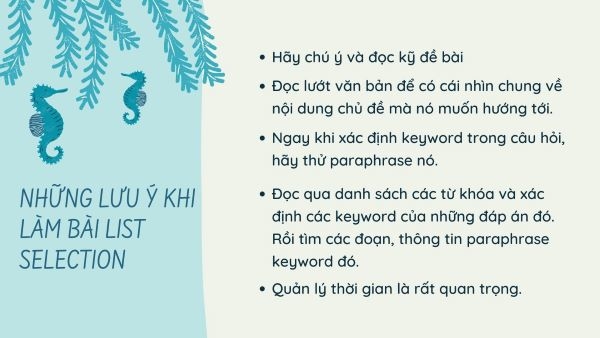


Với những sĩ tử IELTS, dạng bài List Section trong IELTS Reading hẳn không còn quá mới lạ. Nhưng liệu bạn có tự tin mình đã có ăn trọn điểm của dạng bài này hay chưa? Cùng theo dõi bài viết dưới đây để tìm hiểu chiếc lược làm bài siêu đơn giản và hiệu quả chỉ với 4 bước của IELTS LangGo nhé.
“List section” là dạng bài chọn các đáp án từ một danh sách nhất định. Cụ thể, bạn sẽ được cung cấp danh sách khoản 5 -7 ý được đề cập trong bài văn, nhưng bạn sẽ chỉ được chọn 2-3 trong số đáp án đó.
Ví dụ:
“Choose TWO letters, A-E
Write the correct letters in boxes 11 and 12 on your answer sheet. The list below includes factors contributing to classroom noise.
Which TWO are mentioned by the writer of the passage?
A. current teaching methods
B. echoing corridors
C. cooling systems
D. large class sizes
E. loud-voiced teachers
F. playground games”
(Source: Children with auditory problems - mini test)
Dạng câu hỏi này khá giống với các dạng câu hỏi đọc khác của IELTS, chẳng hạn như Multiple Choice hoặc Matching Headings. Sự khác biệt ở đây là tất cả các tùy chọn trong danh sách liên quan đến chủ đề chính của đoạn văn.
Do đó tất cả các câu trả lời có khả năng là đáp án đúng. Kỹ năng đọc lướt (skimming) và đọc hiểu tốt (scanning) đóng văn trò quan trọng ở dạng bài tập này vì việc chú ý đến từng chi tiết sẽ là điều cốt yếu để tìm ra câu trả lời phù hợp nhất.
Với một dạng bài có nhiều bẫy như List selection, việc có một chiến lược làm bài hiệu quả sẽ giúp bạn tiết kiệm được thời gian mà vẫn xử lý “ngon nghẻ” dạng bài này. Cùng tham khảo chiến lược với 4 bước siêu đơn giản của IELT LangGo ngay sau đây bạn nhé.
Bước 1: Đọc kỹ, gạch chân và phân tích những thông tin quan trọng mà đề bài đưa ra: chủ đề mà câu hỏi muốn bạn tìm, số lượng đáp án được chọn,...
Bước 2: Xác định vị trí thông tin có liên quan đến yêu cầu của đề bài
Bước 3: Xác định các paraphrase của câu hỏi và các đáp án trong đoạn văn
Bước 4: Đối chiếu các đáp án với yêu cầu của đề bài và chọn đáp án đúng
Để giúp bạn có một hình dung cụ thể và chi tiết hơn, ngay sau đây, chúng ta sẽ áp dụng chiến lược trên vào một bài Reading IELTS thực tế nhé.
Ví dụ với đoạn văn và đề bài dưới đây:






Đề bài List Selection trong IELTS Reading: Nurturing talent within the family
Choose three options from A to F to fill in the answer box from 30 to 32. You need to select the features of creative families according to the writer.
Bước 1:
Choose three options from A to F to fill in the answer box from 30 to 32. You need to select the features of creative families according to the writer.
Bước 2: Xác định vị trí thông tin có liên quan đến yêu cầu của đề bài
Sử dụng kĩ năng Skimming “the features of creative families”
Two themes seem to run through famously creative families as a result. The first is that the parents were able to identify the talents of each child, and nurture and encourage them accordingly but in an even-handed manner. Individual differences were encouraged, and friendly sibling rivalry was not seen as a particular problem. If the father is, say, a famous actor, there is no undue pressure for his children to follow him onto the boards, but instead their chosen interests are encouraged. There need not even be any obvious talent in such a family since there always needs to be someone who sets the family career in motion, as in the case of the Sheen acting dynasty.
→ Sau khi xác định được vị trí của yêu cầu đề bài, bạn sẽ nhận ra rằng toàn bộ thông tin đáp án đều nằm trong đoạn văn. Việc cần làm bây giờ là tìm paraphrase của các đáp án trong đoạn văn.
Bước 3: Xác định các paraphrase của câu hỏi và các đáp án trong đoạn văn
→ Không tìm thấy
→ Không tìm thấy
→ Thông tin gây nhiễu : identify the talents of each child, not the most talents
Bước 4: Chọn đáp án đúng: Loại trừ ta được đáp án: B, D, E

4 bước làm dạng bài List Selection của IELTS Reading
Bên cạnh một chiến lược làm bài cụ thể, những lưu ý nho nhỏ khí làm các dạng bài tập cũng sẽ giúp thí sinh tiết kiệm được khá nhiều thời gian đó. Cùng tìm hiểu nhé.
Đối với dạng bài này, đề bài sẽ cung cấp cho bạn biết rất nhiều thông tin quan trọng như:
Ví dụ:
Choose TWO letters, A-E
Write the correct letters in boxes 11 and 12 on your answer sheet. The list below includes factors contributing to classroom noise.
Which TWO are mentioned by the writer of the passage?
→ Phân tích:
Bằng cách tự làm quen với đoạn văn, bạn sẽ phát hiện ra vị trí của những keyword trong câu hỏi dễ dàng hơn khi quét văn bản để tìm câu trả lời.
Khi bạn biết chủ đề cần tìm trong văn bản, việc đọc lướt (skimming) cũng sẽ tạo điều kiện cho bạn nhanh chóng nhận ra phần nào của văn bản có khả năng chứa thông tin liên quan và phần nào là thừa.
Những keyword trong câu hỏi sẽ luôn được paraphrase từ các chi tiết trong đoạn văn chính. Vì vậy, thử paraphrase luôn để tiết kiệm thời gian và dễ dàng hơn trong việc xác định chi tiết có liên quan đến câu hỏi.
Đọc qua danh sách các từ khóa và xác định các keyword của những đáp án đó. Tìm các đoạn, thông tin paraphrase keyword đó. Từ đó, xác định xem đáp án nào là đúng với yêu cầu của câu hỏi nhất.
Và hãy nhớ rằng tất cả các tùy chọn trong danh sách là những câu trả lời có thể có liên quan đến chủ đề của văn bản, nhưng sẽ chỉ một số thực sự liên quan đến chủ đề của câu hỏi.
Nên hãy thật tập trung và tỉnh toán để không bị mắc lỗi nhé.
Việc đọc lướt văn bản (skimming) không nên kéo dài quá 2 phút. Bạn nên tập trung vào ý nghĩa tổng thể của cả đoạn văn hơn là hiểu các từ riêng lẻ. Để đảm bảo điều này, hãy đọc câu đầu tiên và câu cuối cùng của mỗi đoạn văn để nắm được ý tưởng mà các đoạn văn muốn truyền đạt.
Chỉ đọc chi tiết sau đó, khi bạn đã xác định được ngôn ngữ và ý tưởng được diễn giải trong văn bản.

Những lưu ý khi làm dạng bài List Selection của IELTS Reading
Cùng LangGo IELTS bước vào làm thử một bài Reading thực sự trong IELTS để xem bạn đã nắm chắc được chiến lược làm bài trên chưa nhé.
Coastal Archeology of Britain
A
The recognition of the wealth and diversity of England’s coastal archaeology has been one of the most important developments of recent years. Some elements of this enormous resource have long been known. The so-called ‘submerged forests’ off the coasts of England, sometimes with clear evidence of human activity, had attracted the interest of antiquarians since at least the eighteenth century, but serious and systematic attention has been given to the archaeological potential of the coast only since the early 1980s.
B
It is possible to trace a variety of causes for this concentration of effort and interest. In the 1980s and 1990s scientific research into climate change and its environmental impact spilled over into a much broader public debate as awareness of these issues grew; the prospect of rising sea levels over the next century, and their impact on current coastal environments, has been a particular focus for concern. At the same time, archaeologists were beginning to recognize that the destruction caused by natural processes of coastal erosion and by human activity was having an increasing impact on the archaeological resource of the coast.
C
The dominant process affecting the physical form of England in the post- glacial period has been rising in the altitude of sea level relative to the land, as the glaciers melted and the landmass readjusted. The encroachment of the sea, the loss of huge areas of land now under the North Sea and the English Channel, and especially the loss of the land bridge between England and France, which finally made Britain an island, must have been immensely significant factors in the lives of our prehistoric ancestors. Yet the way in which prehistoric communities adjusted to these environmental changes has seldom been a major theme in discussions of the period. One factor contributing to this has been that, although the rise in relative sea level is comparatively well documented, we know little about the constant reconfiguration of the coastline. This was affected by many processes, mostly quiet, which have not yet been adequately researched. The detailed reconstruction of coastline histories and the changing environments available for human use will be an important theme for future research.
D
So great has been the rise in sea level and the consequent regression of the coast that much of the archaeological evidence now exposed in the coastal zone. Whether being eroded or exposed as a buried land surface, is derived from what was originally terrestrial occupation. Its current location in the coastal zone is the product of later unrelated processes, and it can tell us little about past adaptations to the sea. Estimates of its significance will need to be made in the context of other related evidence from dry land sites. Nevertheless, its physical environment means that preservation is often excellent, for example in the case of the Neolithic structure excavated at the Stumble in Essex.
E
In some cases these buried land surfaces do contain evidence for human exploitation of what was a coastal environment, and elsewhere along the modem coast, there is similar evidence. Where the evidence does relate to past human exploitation of the resources and the opportunities offered by the sea and the coast, it is both diverse and as yet little understood. We are not yet in a position to make even preliminary estimates of answers to such fundamental questions as the extent to which the sea and the coast affected human life in the past, what percentage of the population at any time lived within reach of the sea, or whether human settlements in coastal environments showed a distinct character from those inland.
F
The most striking evidence for use of the sea is in the form of boats, yet we still have much to learn about their production and use. Most of the known wrecks around our coast are not unexpectedly of post-medieval date, and offer an unparalleled opportunity for research which has yet been little used. The prehistoric sewn-plank boats such as those from the Humber estuary and Dover all seem to belong to the second millennium BC; after this, there is a gap in the record of a millennium, which cannot yet be explained before boats reappear, but it built using a very different technology. Boatbuilding must have been an extremely important activity around much of our coast, yet we know almost nothing about it. Boats were some of the most complex artifacts produced by pre-modem societies, and further research on their production and use make an important contribution to our understanding of past attitudes to technology and technological change.
G
Boats need landing places, yet here again, our knowledge is very patchy. In many cases the natural shores and beaches would have sufficed, leaving little or no archaeological trace, but especially in later periods, many ports and harbors, as well as smaller facilities such as quays, wharves, and jetties, were built. Despite a growth of interest in the waterfront archaeology of some of our more important Roman and medieval towns, very little attention has been paid to the multitude of smaller landing places. Redevelopment of harbor sites and other development and natural pressures along the coast are subject these important locations to unprecedented threats, yet few surveys of such sites have been undertaken.
H
One of the most important revelations of recent research has been the extent of industrial activity along the coast. Fishing and salt production are among the better documented activities, but even here our knowledge is patchy. Many forms of fishing will leave a little archaeological trace, and one of the surprises of the recent survey has been the extent of past investment in facilities for procuring fish and shellfish. Elaborate wooden fish weirs, often of considerable extent and responsive to aerial photography in shallow water, have been identified in areas such as Essex and the Severn estuary. The production of salt, especially in the late Iron Age and early Roman periods, has been recognized for some time, especially in the Thames estuary and around the Solent and Poole Harbor, but the reasons for the decline of that industry and the nature of later coastal salt working are much less well understood. Other industries were also located along the coast, either because the raw materials outcropped there or for ease of working and transport: mineral resources such as sand, gravel, stone, coal, ironstone, and alum were all exploited. These industries are poorly documented, but their remains are sometimes extensive and striking.
I
Some appreciation of the variety and importance of the archaeological remains preserved in the coastal zone, albeit only in preliminary form, can thus be gained from recent work, but the complexity of the problem of managing that resource is also being realized. The problem arises not only from the scale and variety of the archaeological remains, but also from two other sources: the very varied natural and human threats to the resource, and the complex web of organizations with authority over, or interests in, the coastal zone. Human threats include the redevelopment of historic towns and old dockland areas, and the increased importance of the coast for the leisure and tourism industries, resulting in pressure for the increased provision of facilities such as marinas. The larger size of ferries has also caused an increase in the damage caused by their wash to fragile deposits in the intertidal zone. The most significant natural threat is the predicted rise in sea level over the next century especially in the south and east of England. Its impact on archaeology is not easy to predict, and though it is likely to be highly localized, it will be at a scale much larger than that of most archaeological sites. Thus protecting one site may simply result in transposing the threat to a point further along the coast. The management of the archaeological remains will have to be considered in a much longer time scale and a much wider geographical scale than is common in the case of dry land sites, and this will pose a serious challenge for archaeologists.
Questions 24 - 26
Choose THREE letters A-G.
Write your answers in boxes 24 - 26 on your answer sheet.
Which THREE of the following statements are mentioned in the passage?
A. How coastal archaeology was originally discovered
B. It is difficult to understand how many people lived close to the sea.
C. How much the prehistoric communities understand the climate change
D. Our knowledge of boat evidence is limited.
E. Some fishing ground was converted to ports.
F. Human development threatens the archaeological remains.
G. Coastal archaeology will become more important in the future.
→ Đáp án: B, D, F (in any order)
Trên đây là toàn bộ những kiến thức và bài tập thực hành giúp bạn có thể chinh phục dạng bài List selection trong Reading IELTS. Chúc bạn chinh phục thành công Tiếng Anh nói chung và IELTS nói riêng.
Theo dõi LangGo để nắm bắt thêm nhiều bài viết với đa dạng chủ điểm Reading IELTS khác nữa nhé.



ĐẶT LỊCH TƯ VẤN MIỄN PHÍ LỘ TRÌNH Săn ƯU ĐÃI lên tới 12.000.000đ